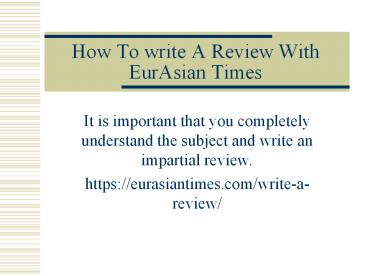Write a Review PowerPoint PPT Presentation
Title: Write a Review
1
How To write A Review With EurAsian Times
- It is important that you completely understand
the subject and write an impartial review. - https//eurasiantimes.com/write-a-review/
2
Outline
- What is a review?
- Why should you review?
- How do you review a paper?
- What not to do?
- What are the dilemmas?
- Case study
3
What is a review?
- Something that will ruin your day Alan Bundy
- Even if it is good!
- The stamp of scientific quality
- Feedback from your peers
- Future directions?
4
What is a review not?
- Acceptance/rejection
- Editors/Program committees accept/reject
- You recommend!
- A place for bias, prejudice, personal animosity,
- Though it often appears to be so
5
Why should you review?
- Youd much rather enjoy Paphos
- And so would I!
- But science would grind to a halt
- Not immediately, of course
6
Reasons to review
- Duty
- Fairness
- 2-3 reviews written/ paper written
- Promotion
- Education
- Good reviewers write good papers?
7
Bad reasons to review
- To settle old scores
- To advance your own theories/hinder rivals
- To get latest results
- Unpublished papers are strictly confidential
8
How do you review?
- Read the paper
- Read the review form
- Useful dimensions to look at
- Novelty, Clarity, Importance, Timeliness
- Read the paper
- Wait a few days
- Read paper
- Write review
- Everyone has their own method
9
How do you review?
- Put yourself in authors shoes
- Think how you would like to read this review
- Offer constructive criticism
- Dont just tell them something is inadequate!
- Tell them how they might fix it
10
What not to do?
- Miss the deadline
- We all hate late reviews
- Display partiality, bias, animosity,
- Destructively criticize
- Always work out what they would need to do to fix
problems
11
Collect and share reviews
- Learn if others agree with your opinions
- Thicken your skin
- Clearly, the author fails to understand the work
of Walsh in this area - Since they mention no related work, this paper
cannot be original - This idea is too simple not to exist already
- This work is good but I dont understand why
Bundy hasnt done this already?
12
Ethical dilemmas
- You are working on the same problem
- Talk to Editor/Program Chair
- You already reviewed and rejected paper
- Look for changes
13
Ethical dilemmas
- This journal submission already appeared at a
conference - Does it extend previous appearance?
- An almost identical paper already appeared
- Unless it was at a workshop, inform Editor/Chair
14
Case study
- Stochastic Constraint Programming
- By Toby Walsh
- Be frank, the feedback is good!
- What do you think?
15
What did reviewer 1 think?
- Appears to like it
- Main criticisms
- Relationship to influence diagrams
- Algorithm performance
- Phase transition too preliminary
Its easier than ever to write a review and get
it published nowadays. As long as you observe
few simple instructions to write a review you
can convince a media organizations, websites,
and editors to publish your reviews which may be
newsworthy. Here are few tips to Write a Review
with EurAsian Times.
16
What did reviewer 2 think?
- Appears to like it
- Very relevant
- Moderately significant/original
- Good readability/English
- Minimal comments
Total of their written comments It would be
nice to include the exact syntax of one
SCprogram, as accepted by your system (?), say,
for the example of Section 3.
17
What did reviewer 3 think?
- Again appears to like it
- Very relevant, very original, moderately
significant - Main criticisms
- Relationship to influence diagrams
- Phase transition too preliminary
Clearly, one could just add constraints to
influence diagram representation and extend
algorithms to exploit them (my preferred
approach) but the approach here is still very
valid and could motivate researchers in MDPs and
influence diagrams to treat constraints as
special creatures so that their special
algorithms can be exploited. I think the
experimental portion of the paper should have
been to compare the performance of the
algorithms with the performance of traditional
MDPs or influence diagram algorithms applied to
this class of problems and I speculate that gain
can be shown. I dont find the phase transition
experiments of much value at this stage. So,
there may be a phase transition, so what? I
recommend that the author will carefully analyze
their model against standard influnce diagrams or
factored MDPs and discuss the pros and cons.
18
Conclusions
- Reviewing can be rewarding
- Both to authors and to reviewers
- Be constructive
- Think how you would react to the review
- Take on board your reviews
- Reviewers hate most being ignored!

